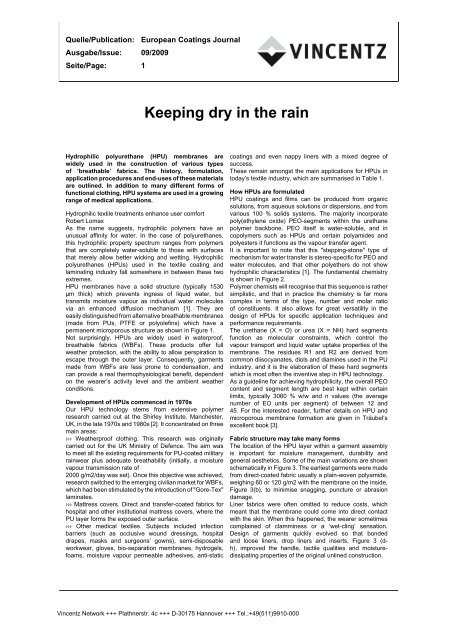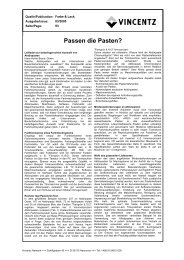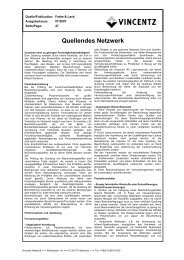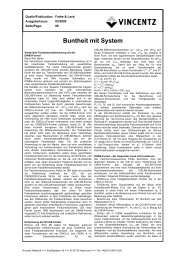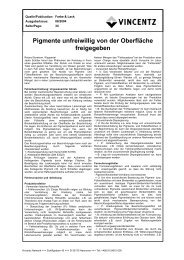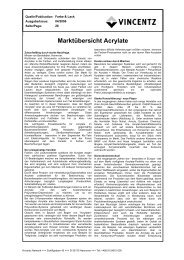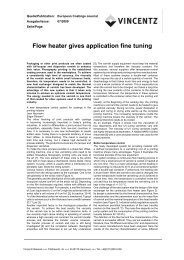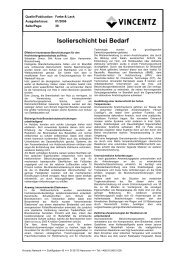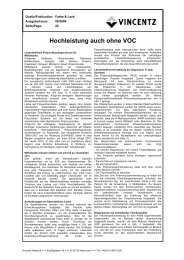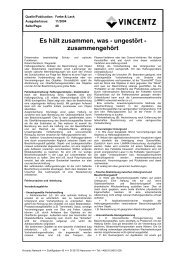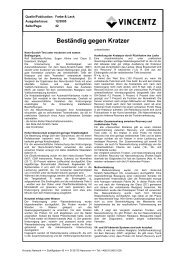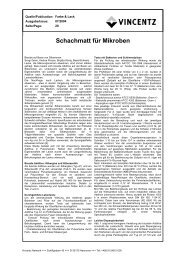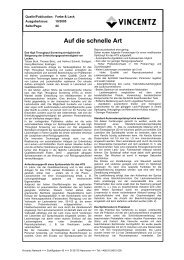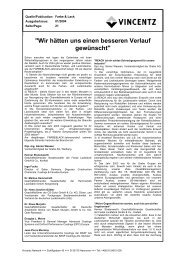Keeping dry in the rain - European-coatings.com
Keeping dry in the rain - European-coatings.com
Keeping dry in the rain - European-coatings.com
Create successful ePaper yourself
Turn your PDF publications into a flip-book with our unique Google optimized e-Paper software.
.<br />
Quelle/Publication: <strong>European</strong> Coat<strong>in</strong>gs Journal<br />
Ausgabe/Issue: 09/2009<br />
Seite/Page: 1<br />
<strong>Keep<strong>in</strong>g</strong> <strong>dry</strong> <strong>in</strong> <strong>the</strong> ra<strong>in</strong><br />
Hydrophilic polyurethane (HPU) membranes are<br />
widely used <strong>in</strong> <strong>the</strong> construction of various types<br />
of ‘breathable’ fabrics. The history, formulation,<br />
application procedures and end-uses of <strong>the</strong>se materials<br />
are outl<strong>in</strong>ed. In addition to many different forms of<br />
functional cloth<strong>in</strong>g, HPU systems are used <strong>in</strong> a grow<strong>in</strong>g<br />
range of medical applications.<br />
Hydrophilic textile treatments enhance user <strong>com</strong>fort<br />
Robert Lomax<br />
As <strong>the</strong> name suggests, hydrophilic polymers have an<br />
unusual aff<strong>in</strong>ity for water. In <strong>the</strong> case of polyurethanes,<br />
this hydrophilic property spectrum ranges from polymers<br />
that are <strong>com</strong>pletely water-soluble to those with surfaces<br />
that merely allow better wick<strong>in</strong>g and wett<strong>in</strong>g. Hydrophilic<br />
polyurethanes (HPUs) used <strong>in</strong> <strong>the</strong> textile coat<strong>in</strong>g and<br />
lam<strong>in</strong>at<strong>in</strong>g <strong>in</strong>dustry fall somewhere <strong>in</strong> between <strong>the</strong>se two<br />
extremes.<br />
HPU membranes have a solid structure (typically 1530<br />
µm thick) which prevents <strong>in</strong>gress of liquid water, but<br />
transmits moisture vapour as <strong>in</strong>dividual water molecules<br />
via an enhanced diffusion mechanism [1]. They are<br />
easily dist<strong>in</strong>guished from alternative breathable membranes<br />
(made from PUs, PTFE or polyolef<strong>in</strong>s) which have a<br />
permanent microporous structure as shown <strong>in</strong> Figure 1.<br />
Not surpris<strong>in</strong>gly, HPUs are widely used <strong>in</strong> waterproof,<br />
breathable fabrics (WBFs). These products offer full<br />
wea<strong>the</strong>r protection, with <strong>the</strong> ability to allow perspiration to<br />
escape through <strong>the</strong> outer layer. Consequently, garments<br />
made from WBFs are less prone to condensation, and<br />
can provide a real <strong>the</strong>rmophysiological benefit, dependent<br />
on <strong>the</strong> wearer’s activity level and <strong>the</strong> ambient wea<strong>the</strong>r<br />
conditions.<br />
Development of HPUs <strong>com</strong>menced <strong>in</strong> 1970s<br />
Our HPU technology stems from extensive polymer<br />
research carried out at <strong>the</strong> Shirley Institute, Manchester,<br />
UK, <strong>in</strong> <strong>the</strong> late 1970s and 1980s [2]. It concentrated on three<br />
ma<strong>in</strong> areas:<br />
››› Wea<strong>the</strong>rproof cloth<strong>in</strong>g. This research was orig<strong>in</strong>ally<br />
carried out for <strong>the</strong> UK M<strong>in</strong>istry of Defence. The aim was<br />
to meet all <strong>the</strong> exist<strong>in</strong>g requirements for PU-coated military<br />
ra<strong>in</strong>wear plus adequate breathability (<strong>in</strong>itially, a moisture<br />
vapour transmission rate of<br />
2000 g/m2/day was set). Once this objective was achieved,<br />
research switched to <strong>the</strong> emerg<strong>in</strong>g civilian market for WBFs,<br />
which had been stimulated by <strong>the</strong> <strong>in</strong>troduction of "Gore-Tex"<br />
lam<strong>in</strong>ates.<br />
››› Mattress covers. Direct and transfer-coated fabrics for<br />
hospital and o<strong>the</strong>r <strong>in</strong>stitutional mattress covers, where <strong>the</strong><br />
PU layer forms <strong>the</strong> exposed outer surface.<br />
››› O<strong>the</strong>r medical textiles. Subjects <strong>in</strong>cluded <strong>in</strong>fection<br />
barriers (such as occlusive wound dress<strong>in</strong>gs, hospital<br />
drapes, masks and surgeons’ gowns), semi-disposable<br />
workwear, gloves, bio-separation membranes, hydrogels,<br />
foams, moisture vapour permeable adhesives, anti-static<br />
coat<strong>in</strong>gs and even nappy l<strong>in</strong>ers with a mixed degree of<br />
success.<br />
These rema<strong>in</strong> amongst <strong>the</strong> ma<strong>in</strong> applications for HPUs <strong>in</strong><br />
today’s textile <strong>in</strong>dustry, which are summarised <strong>in</strong> Table 1.<br />
How HPUs are formulated<br />
HPU coat<strong>in</strong>gs and films can be produced from organic<br />
solutions, from aqueous solutions or dispersions, and from<br />
various 100 % solids systems. The majority <strong>in</strong>corporate<br />
poly(ethylene oxide) PEO-segments with<strong>in</strong> <strong>the</strong> urethane<br />
polymer backbone. PEO itself is water-soluble, and <strong>in</strong><br />
copolymers such as HPUs and certa<strong>in</strong> polyamides and<br />
polyesters it functions as <strong>the</strong> vapour transfer agent.<br />
It is important to note that this "stepp<strong>in</strong>g-stone" type of<br />
mechanism for water transfer is stereo-specific for PEO and<br />
water molecules, and that o<strong>the</strong>r polye<strong>the</strong>rs do not show<br />
hydrophilic characteristics [1]. The fundamental chemistry<br />
is shown <strong>in</strong> Figure 2.<br />
Polymer chemists will recognise that this sequence is ra<strong>the</strong>r<br />
simplistic, and that <strong>in</strong> practice <strong>the</strong> chemistry is far more<br />
<strong>com</strong>plex <strong>in</strong> terms of <strong>the</strong> type, number and molar ratio<br />
of constituents. It also allows for great versatility <strong>in</strong> <strong>the</strong><br />
design of HPUs for specific application techniques and<br />
performance requirements.<br />
The urethane (X = O) or urea (X = NH) hard segments<br />
function as molecular constra<strong>in</strong>ts, which control <strong>the</strong><br />
vapour transport and liquid water uptake properties of <strong>the</strong><br />
membrane. The residues R1 and R2 are derived from<br />
<strong>com</strong>mon diisocyanates, diols and diam<strong>in</strong>es used <strong>in</strong> <strong>the</strong> PU<br />
<strong>in</strong>dustry, and it is <strong>the</strong> elaboration of <strong>the</strong>se hard segments<br />
which is most often <strong>the</strong> <strong>in</strong>ventive step <strong>in</strong> HPU technology.<br />
As a guidel<strong>in</strong>e for achiev<strong>in</strong>g hydrophilicity, <strong>the</strong> overall PEO<br />
content and segment length are best kept with<strong>in</strong> certa<strong>in</strong><br />
limits, typically 3060 % w/w and n values (<strong>the</strong> average<br />
number of EO units per segment) of between 12 and<br />
45. For <strong>the</strong> <strong>in</strong>terested reader, fur<strong>the</strong>r details on HPU and<br />
microporous membrane formation are given <strong>in</strong> Träubel’s<br />
excellent book [3].<br />
Fabric structure may take many forms<br />
The location of <strong>the</strong> HPU layer with<strong>in</strong> a garment assembly<br />
is important for moisture management, durability and<br />
general aes<strong>the</strong>tics. Some of <strong>the</strong> ma<strong>in</strong> variations are shown<br />
schematically <strong>in</strong> Figure 3. The earliest garments were made<br />
from direct-coated fabric usually a pla<strong>in</strong>-woven polyamide,<br />
weigh<strong>in</strong>g 60 or 120 g/m2 with <strong>the</strong> membrane on <strong>the</strong> <strong>in</strong>side,<br />
Figure 3(b), to m<strong>in</strong>imise snagg<strong>in</strong>g, puncture or abrasion<br />
damage.<br />
L<strong>in</strong>er fabrics were often omitted to reduce costs, which<br />
meant that <strong>the</strong> membrane could <strong>com</strong>e <strong>in</strong>to direct contact<br />
with <strong>the</strong> sk<strong>in</strong>. When this happened, <strong>the</strong> wearer sometimes<br />
<strong>com</strong>pla<strong>in</strong>ed of clamm<strong>in</strong>ess or a ‘wet-cl<strong>in</strong>g’ sensation.<br />
Design of garments quickly evolved so that bonded<br />
and loose l<strong>in</strong>ers, drop l<strong>in</strong>ers and <strong>in</strong>serts, Figure 3 (dh),<br />
improved <strong>the</strong> handle, tactile qualities and moisturedissipat<strong>in</strong>g<br />
properties of <strong>the</strong> orig<strong>in</strong>al unl<strong>in</strong>ed construction.<br />
V<strong>in</strong>centz Network +++ Plathnerstr. 4c +++ D-30175 Hannover +++ Tel.:+49(511)9910-000
.<br />
Quelle/Publication: <strong>European</strong> Coat<strong>in</strong>gs Journal<br />
Ausgabe/Issue: 09/2009<br />
Seite/Page: 2<br />
Simple l<strong>in</strong>ers based on lightweight scrims or tricots can<br />
be replaced by wadd<strong>in</strong>gs or o<strong>the</strong>r bulky textiles for added<br />
<strong>in</strong>sulation <strong>in</strong> garments that <strong>com</strong>b<strong>in</strong>e foul- and cold-wea<strong>the</strong>r<br />
protection.<br />
HPUs can be applied to textiles by <strong>the</strong> well-established<br />
techniques of direct coat<strong>in</strong>g, transfer coat<strong>in</strong>g (us<strong>in</strong>g<br />
siliconised belts or release papers) and film lam<strong>in</strong>ation.<br />
WBFs, for example, are normally made <strong>in</strong> cont<strong>in</strong>uous rolls,<br />
with lengths vary<strong>in</strong>g between 100 and 5000 m and widths of<br />
1.5 1.8 m for apparel. Wider mach<strong>in</strong>ery (up to 2.23.0 m) is<br />
required for certa<strong>in</strong> end-uses such as tarpaul<strong>in</strong>s, mattress<br />
covers and horse blankets.<br />
Performance requirements summarised<br />
The coat<strong>in</strong>g weight for WBFs varies accord<strong>in</strong>g to <strong>the</strong> fabric,<br />
but is typically 2025 g/m2 for lightweight syn<strong>the</strong>tic fabrics<br />
and up to 5070 g/m2 for heavier syn<strong>the</strong>tic, cotton, cotton/<br />
polyester and textured fabrics such as Cordura. This usually<br />
represents an effective barrier layer thickness of 2030 µm,<br />
an optimum for a good balance of water vapour transfer<br />
properties, liquid water resistance and general durability.<br />
A respected performance benchmark is EN 343:2003,<br />
which "specifies requirements and test methods applicable<br />
to materials and seams of protective cloth<strong>in</strong>g aga<strong>in</strong>st <strong>the</strong><br />
<strong>in</strong>fluence of precipitation (e.g. ra<strong>in</strong>, snowflakes), fog and<br />
ground humidity". It classifies three grades of fabric, where<br />
<strong>the</strong> technical balance of properties improves progressively<br />
from Class 1 (effectively non-breathable) through to Class<br />
3, as shown <strong>in</strong> Table 2.<br />
A good HPU-coated fabric or lam<strong>in</strong>ate should easily satisfy<br />
Class 3 requirements. Our orig<strong>in</strong>al HPUs were prepared<br />
<strong>in</strong> solvent for coat<strong>in</strong>g directly onto <strong>the</strong> surface of closelywoven<br />
filament nylon and polyester fabrics us<strong>in</strong>g knife-overroll<br />
and knife-on-air techniques. This rema<strong>in</strong>s a major outlet<br />
for HPU, and it can be used to illustrate WBF manufacture.<br />
Multilayer coat<strong>in</strong>gs provide optimum performance<br />
Solvent-based HPUs are typically made <strong>in</strong> 1015 tonne<br />
batches, and resemble golden syrup <strong>in</strong> appearance and<br />
‘spread<strong>in</strong>g’ consistency. As a broad guidel<strong>in</strong>e, 1 tonne of<br />
HPU solution will coat 10,000 runn<strong>in</strong>g metres of mediumweight<br />
polyester fabric, sufficient to make about 7000<br />
average-size anoraks.<br />
Direct coat<strong>in</strong>gs are non-uniform <strong>in</strong> thickness, because <strong>the</strong><br />
applied <strong>com</strong>pound follows <strong>the</strong> surface contours of <strong>the</strong> fabric<br />
and fills <strong>in</strong> <strong>the</strong> <strong>in</strong>terstices between yarns. They usually have<br />
a stratified <strong>com</strong>position, as <strong>in</strong> Figure 1(f), with each layer<br />
hav<strong>in</strong>g a different chemistry and fulfill<strong>in</strong>g a different function.<br />
For <strong>in</strong>stance:<br />
››› Base coats are normally very soft and extensible, to<br />
m<strong>in</strong>imise <strong>the</strong> natural stiffen<strong>in</strong>g effect on fabric handle and<br />
aes<strong>the</strong>tics. Crossl<strong>in</strong>kers are required to provide adequate<br />
"wet" properties <strong>in</strong> use, durability and chemical bond<strong>in</strong>g<br />
as well as mechanical adhesion to <strong>the</strong> base substrate.<br />
They are normally supplied as 4555 % solids <strong>in</strong> methyl<br />
ethyl ketone (MEK) or ethyl acetate, with solution viscosities<br />
of 200-400 poise. Multifunctional isocyanate or MF res<strong>in</strong><br />
crossl<strong>in</strong>kers, diluents and optional additives such as<br />
pigments and flame retardants can be mixed <strong>in</strong> just prior to<br />
use.<br />
››› Middle coat(s) often have a similar chemistry to base<br />
coats, and are usually applied as fill<strong>in</strong>g layers to <strong>in</strong>crease<br />
<strong>the</strong> weight and thickness of <strong>the</strong> protective layer. Skimp<strong>in</strong>g<br />
on coat<strong>in</strong>g weight is often false economy, especially with<br />
<strong>the</strong> more uneven substrates. Unless surface protrusions<br />
are <strong>com</strong>pletely encased by <strong>the</strong> polymer coat<strong>in</strong>g, <strong>the</strong>y<br />
rema<strong>in</strong> weak spots and <strong>the</strong> coated fabric is more prone to<br />
hydrostatic failure <strong>in</strong> use.<br />
››› Top coat HPUs are tougher, more abrasion resistant<br />
and usually less hydrophilic than o<strong>the</strong>r layers. The polymers<br />
show strong <strong>in</strong>termolecular hydrogen bond<strong>in</strong>g, and require<br />
more powerful solvents such as dimethylformamide (DMF)<br />
or DMF blends to produce coat<strong>in</strong>g solutions (typically at<br />
2530 % solids).<br />
Top coats usually conta<strong>in</strong> f<strong>in</strong>ely-divided silica to reduce<br />
gloss. Crossl<strong>in</strong>kers are not required, because <strong>the</strong> top coat<br />
must rema<strong>in</strong> <strong>the</strong>rmoplastic and suitable for hot-air tap<strong>in</strong>g.<br />
This is a technique for apply<strong>in</strong>g narrow heat-seal<strong>in</strong>g tapes<br />
over <strong>the</strong> stitch<strong>in</strong>g <strong>in</strong>side garments to make <strong>the</strong> seams fully<br />
waterproof.<br />
As each layer is progressively built up, <strong>the</strong> solvent is<br />
removed and <strong>the</strong> dried layer be<strong>com</strong>es <strong>the</strong> substrate for <strong>the</strong><br />
next. The best practice is to carry this out <strong>in</strong> a one-pass<br />
operation and l<strong>in</strong>es with 2, 3 and even 4 coat<strong>in</strong>g heads and<br />
associated ovens <strong>in</strong> tandem are now <strong>com</strong>monplace.<br />
These mach<strong>in</strong>e l<strong>in</strong>es can be up to 100 m long, operat<strong>in</strong>g<br />
at speeds of 15 40 m/m<strong>in</strong>. The coat<strong>in</strong>g as a whole must be<br />
fully consolidated at <strong>the</strong> end of <strong>the</strong> operation, with all layers<br />
work<strong>in</strong>g <strong>in</strong> unison. This requires close control of successive<br />
<strong>dry</strong><strong>in</strong>g and cur<strong>in</strong>g cycles, so that all solvents have been<br />
removed and adequate crossl<strong>in</strong>k<strong>in</strong>g has taken place before<br />
<strong>the</strong> coated fabric is f<strong>in</strong>ally wound up.<br />
Transfer coat<strong>in</strong>g is useful on ‘difficult’ fabrics<br />
Similar solvent-borne HPUs can be used for transfer<br />
coat<strong>in</strong>g, where <strong>the</strong> HPU layers are laid down <strong>in</strong> reverse<br />
order, i.e. top-middle-base. The first (top coat) layer is<br />
applied onto a cont<strong>in</strong>uous roll of siliconised release paper,<br />
which takes all <strong>the</strong> applied mach<strong>in</strong>e tensions. This top coat<br />
is dried and subsequent coat(s) are applied.<br />
Whilst <strong>the</strong> f<strong>in</strong>al base (or tie) coat is still tacky, <strong>the</strong> fabric<br />
substrate is brought <strong>in</strong>to contact with it under a nip roll.<br />
The film-fabric-paper lam<strong>in</strong>ate <strong>the</strong>n passes through <strong>the</strong> f<strong>in</strong>al<br />
<strong>dry</strong><strong>in</strong>g/cur<strong>in</strong>g oven and onto <strong>the</strong> w<strong>in</strong>d<strong>in</strong>g station, where <strong>the</strong><br />
coated fabric and paper are stripped apart and separately<br />
wound up.<br />
This technique allows open, flimsy and dimensionally<br />
unstable fabrics such as coarse weaves, knits, nonwovens<br />
and scrims to be used as carriers. Release papers can be<br />
re-used a number of times, but <strong>the</strong>y make <strong>the</strong> process more<br />
costly than direct coat<strong>in</strong>g.<br />
Transfer coat<strong>in</strong>g mach<strong>in</strong>ery can also be used to produce<br />
uniformly th<strong>in</strong> HPU membranes which are stripped from <strong>the</strong><br />
paper and wound up as a free-stand<strong>in</strong>g film, or <strong>in</strong>terleaved<br />
with a release carrier such as poly<strong>the</strong>ne sheet. Cast-film<br />
production has some advantages, e.g. for small production<br />
runs <strong>in</strong>corporat<strong>in</strong>g a variety of pigments, biocides, special<br />
effect additives etc. The ma<strong>in</strong> applications for cast HPU film<br />
are customised WBFs and medical textiles.<br />
Solvent emissions can be reduced <strong>in</strong> various ways<br />
Environmental legislation and <strong>the</strong> recurr<strong>in</strong>g threat to<br />
coat<strong>in</strong>g <strong>com</strong>panies us<strong>in</strong>g large volumes of solvent-based<br />
hydrophilic PU prompted <strong>the</strong> development of water-based<br />
systems <strong>in</strong> <strong>the</strong> early 1990s. They have some drawbacks,<br />
most of which arise from <strong>the</strong> physical properties of water<br />
itself. Never<strong>the</strong>less, aqueous HPUs are successfully used<br />
by a number of coaters <strong>in</strong> <strong>the</strong> textile <strong>in</strong>dustry.<br />
V<strong>in</strong>centz Network +++ Plathnerstr. 4c +++ D-30175 Hannover +++ Tel.:+49(511)9910-000
.<br />
Quelle/Publication: <strong>European</strong> Coat<strong>in</strong>gs Journal<br />
Ausgabe/Issue: 09/2009<br />
Seite/Page: 3<br />
100 % solids systems are hydrophilic versions of<br />
<strong>the</strong>rmoplastic PUs (HTPUs), manufactured by a solventfree<br />
process follow<strong>in</strong>g <strong>the</strong> basic chemistry shown <strong>in</strong> Figure<br />
2. They are used <strong>in</strong> two ways by <strong>the</strong> <strong>in</strong>dustry. HTPU<br />
pellets can be dissolved and converted <strong>in</strong>to homogeneous<br />
coat<strong>in</strong>g solutions, typically 2530 % solids <strong>in</strong> DMF or o<strong>the</strong>r<br />
strong solvents. These solutions can <strong>the</strong>n be used for<br />
normal direct and transfer coat<strong>in</strong>g operations, as outl<strong>in</strong>ed<br />
above. Conversely, HTPUs can be <strong>the</strong>rmally reprocessed<br />
above <strong>the</strong>ir melt<strong>in</strong>g po<strong>in</strong>ts (ca. 180190 °C) for calender<strong>in</strong>g/<br />
extrusion coat<strong>in</strong>g onto fabrics and for blown film extrusion.<br />
Reactive PU hot-melt adhesives are special types of HTPU<br />
characterised by relatively low molecular weights, low<br />
melt<strong>in</strong>g po<strong>in</strong>ts and free isocyanate contents of ca. 35 %.<br />
They are designed as one-<strong>com</strong>ponent adhesives applied<br />
<strong>in</strong> <strong>the</strong> molten state, typically at temperatures of 90140 °C,<br />
us<strong>in</strong>g a screen pr<strong>in</strong>t<strong>in</strong>g unit, slot nozzles or more usually a<br />
heated gravure-roll coater.<br />
Once on <strong>the</strong> substrate, <strong>the</strong> polymer layer absorbs<br />
atmospheric moisture, which <strong>in</strong>itiates a series of irreversible<br />
cha<strong>in</strong> extension, adhesion promotion and crossl<strong>in</strong>k<strong>in</strong>g<br />
reactions with<strong>in</strong> <strong>the</strong> PU molecular network. These products<br />
have extremely good solvent, wash and <strong>dry</strong> clean<strong>in</strong>g<br />
resistance <strong>com</strong>pared with o<strong>the</strong>r textile adhesives.<br />
This is a relatively new, but grow<strong>in</strong>g, area for HPUs<br />
<strong>in</strong> textiles. The ma<strong>in</strong> <strong>in</strong>terest to date is for lam<strong>in</strong>at<strong>in</strong>g<br />
breathable membranes, especially ePTFE, to a fabric or<br />
fabrics. Us<strong>in</strong>g a cont<strong>in</strong>uous, breathable adhesive layer<br />
ma<strong>in</strong>ta<strong>in</strong>s <strong>the</strong> high water vapour transport of <strong>the</strong> membrane,<br />
and at <strong>the</strong> same time optimises coverage and bond<br />
strength.<br />
REFERENCES<br />
[ [1] Lomax G. R., J. Mater. Chem., 2007, 17, 2775-2784<br />
[2] Lomax G. R., J. Coated Fabrics, 1985, 15, 4066 [3]<br />
Träubel H., New Materials Permeable to Water Vapor,<br />
Spr<strong>in</strong>gerVerlag, Berl<strong>in</strong>, 1999, part 4, pp.107-213 [4]<br />
Baxenden Chemicals Ltd., World Patent 2006 075 144<br />
Results at a glance<br />
Hydrophilic polyurethane (HPU) membranes are widely<br />
used <strong>in</strong> <strong>the</strong> construction of various types of ‘breathable’<br />
fabrics. Unlike o<strong>the</strong>r breathable systems, <strong>the</strong>y do not<br />
conta<strong>in</strong> physical micropores but rely on <strong>the</strong> hydrophilic<br />
properties of polyethylene oxide with<strong>in</strong> <strong>the</strong> polymer to<br />
transport moisture. A number of different multilayer fabric<br />
constructions are used to enhance wearer <strong>com</strong>fort. The<br />
coat<strong>in</strong>gs <strong>the</strong>mselves are usually multilayer, to optimise<br />
bond<strong>in</strong>g to <strong>the</strong> fabric (base coat) ensure full coverage and<br />
effective moisture transport (mid coat) and provide abrasion<br />
resistance (top coat). HPU systems are used not only<br />
<strong>in</strong> many forms of functional cloth<strong>in</strong>g, but also <strong>in</strong> medical<br />
applications rang<strong>in</strong>g from wound dress<strong>in</strong>gs to mattress<br />
covers. When <strong>the</strong> membrane forms <strong>the</strong> outer, visible layer<br />
of a material, it may be necessary to restrict <strong>the</strong> (reversible)<br />
swell<strong>in</strong>g of <strong>the</strong> HPU which occurs dur<strong>in</strong>g moisture pick-up.<br />
Water swell<strong>in</strong>g sometimes has to be m<strong>in</strong>imised<br />
HPUs transport moisture vapour by a mechanism that<br />
encourages its rapid absorption <strong>in</strong>to <strong>the</strong> polymer. At high<br />
humidities, and especially when liquid water is <strong>in</strong> contact<br />
with <strong>the</strong> polymer, this causes <strong>the</strong> HPU layer to swell. Once<br />
<strong>the</strong> moisture is removed, <strong>the</strong> polymer returns to its normal<br />
state.<br />
For most end-uses, this layer is hidden from view and <strong>the</strong><br />
reversible swell<strong>in</strong>g mechanism goes unnoticed. However,<br />
<strong>in</strong> some important applications such as mattress covers,<br />
medical dress<strong>in</strong>gs, shoes and easy-wipe workwear, <strong>the</strong><br />
membrane forms <strong>the</strong> visible outer layer, as <strong>in</strong> Figure 3(c).<br />
Normal HPUs are rarely used here, because <strong>the</strong>y may<br />
develop unsightly wr<strong>in</strong>kl<strong>in</strong>g or water-spott<strong>in</strong>g effects <strong>in</strong> wet<br />
or ra<strong>in</strong>y conditions.<br />
Most approaches to solv<strong>in</strong>g this problem lead to an<br />
<strong>in</strong>evitable trade-off between breathability and dimensional<br />
swell<strong>in</strong>g. Baxenden has developed a top coat system<br />
based on PEO-free PUs that have exceptionally low water<br />
uptake (< 2 % w/w) yet reasonable water vapour transfer<br />
properties when <strong>the</strong>y form part of an <strong>in</strong>tegrated coat<strong>in</strong>g<br />
system.<br />
They fit <strong>in</strong>to a spectrum of products where breathability<br />
and swell<strong>in</strong>g can be traded off to suit a particular<br />
application, depend<strong>in</strong>g on membrane thickness, see Figure<br />
4. Composite membranes, e.g. trilayers of low, medium<br />
and high swell propensity, show <strong>in</strong>terest<strong>in</strong>g anisotropic<br />
behaviour where breathability depends on <strong>the</strong> direction of<br />
water vapour flow and <strong>the</strong> stack<strong>in</strong>g order of <strong>the</strong> <strong>in</strong>dividual<br />
layers [4]. This is a development area that <strong>com</strong>plements <strong>the</strong><br />
<strong>com</strong>pany’s exist<strong>in</strong>g HPU technology.<br />
V<strong>in</strong>centz Network +++ Plathnerstr. 4c +++ D-30175 Hannover +++ Tel.:+49(511)9910-000
.<br />
Quelle/Publication: <strong>European</strong> Coat<strong>in</strong>gs Journal<br />
Ausgabe/Issue: 09/2009<br />
Seite/Page: 4<br />
Figure 1: Some features of membranes used <strong>in</strong> waterproof breathable fabrics<br />
(WBFs). Top row: surfaces of membranes; bottom row, sections through<br />
coat<strong>in</strong>gs, lam<strong>in</strong>ated to polyamide fabric unless o<strong>the</strong>rwise stated. Left to right:<br />
Solid hydrophilic coat<strong>in</strong>g (a) show<strong>in</strong>g multiple layers at (f); Microporous PU<br />
produced by wet coagulation (b) and (g); Microporous PU produced by phase<br />
separation (c) with very th<strong>in</strong> pore-seal<strong>in</strong>g topcoat shown at (h); Mechanicallyfoamed<br />
PU dispersion (d) with mechanically-foamed acrylic coat<strong>in</strong>g shown <strong>in</strong><br />
(i) with first layer crushed; ePTFE membrane (e) and PU film produced by salt<br />
extraction lam<strong>in</strong>ated to polyester with discont<strong>in</strong>uous adhesive (shown as solid<br />
dots) (j)<br />
V<strong>in</strong>centz Network +++ Plathnerstr. 4c +++ D-30175 Hannover +++ Tel.:+49(511)9910-000
.<br />
Quelle/Publication: <strong>European</strong> Coat<strong>in</strong>gs Journal<br />
Ausgabe/Issue: 09/2009<br />
Seite/Page: 5<br />
Figure 2: Basic reaction sequence for<br />
manufactur<strong>in</strong>g HPUs based on PEO<br />
V<strong>in</strong>centz Network +++ Plathnerstr. 4c +++ D-30175 Hannover +++ Tel.:+49(511)9910-000
.<br />
Quelle/Publication: <strong>European</strong> Coat<strong>in</strong>gs Journal<br />
Ausgabe/Issue: 09/2009<br />
Seite/Page: 6<br />
Figure 3: Schematic diagram of outer<br />
garment constructions <strong>in</strong>corporat<strong>in</strong>g<br />
WBFs: (a) membrane only; (b) basic<br />
2layer fabric with coat<strong>in</strong>g on <strong>in</strong>side,<br />
water repellenttreated outer surface;<br />
(c) basic 2layer fabric with coat<strong>in</strong>g<br />
on outside; (d) 2layer plus loose l<strong>in</strong>er<br />
fabric; (e) typical pictogram show<strong>in</strong>g<br />
breathability and wea<strong>the</strong>rproofness<br />
of a 3layer lam<strong>in</strong>ate (often used <strong>in</strong><br />
advertis<strong>in</strong>g, brochures and sw<strong>in</strong>g<br />
tickets); (f) loose outer fabric plus<br />
scrimsupported membrane (drop<br />
l<strong>in</strong>er); (g) drop l<strong>in</strong>er <strong>in</strong>sert; (h) double<br />
membrane system, e.g. "Dual<br />
Protection" us<strong>in</strong>g ‘cold bridg<strong>in</strong>g’<br />
pr<strong>in</strong>ciple<br />
V<strong>in</strong>centz Network +++ Plathnerstr. 4c +++ D-30175 Hannover +++ Tel.:+49(511)9910-000
.<br />
Quelle/Publication: <strong>European</strong> Coat<strong>in</strong>gs Journal<br />
Ausgabe/Issue: 09/2009<br />
Seite/Page: 7<br />
Figure 4: Breathability wedges<br />
for textilegrade HPU membranes<br />
(show<strong>in</strong>g water uptake w/w): (a)<br />
nonbreathable (13 %); (b) low-swell<br />
development, top-coat (13 %); (c)<br />
hybrids of low swell/hydrophilic (1025<br />
%); (d) hydrophilic top coat layer (4070<br />
%); (e) hydrophilic base coat layer<br />
(70100 %)<br />
V<strong>in</strong>centz Network +++ Plathnerstr. 4c +++ D-30175 Hannover +++ Tel.:+49(511)9910-000


